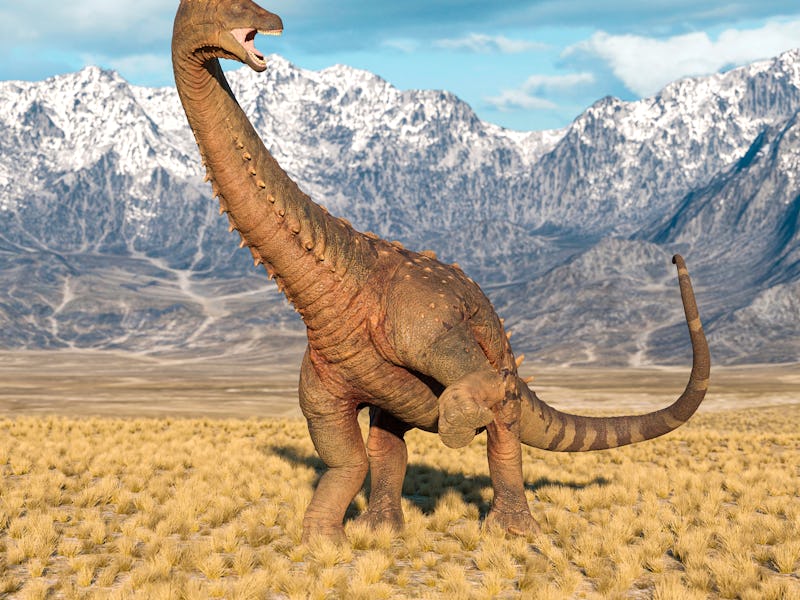Dinosaur fossils complicate our understanding of how they reproduced
The chicken doesn’t fall far from the dino.

In 1877, English naturalist Richard Lydekker unearthed the first titanosaur fossil in the Lameta Formation in central India. Many more fossils would come from the subcontinent in the decades to follow.
Titanosaurs were sauropods — long-necked herbivores with four trunk-like legs who lived between 66 million and 140 million years ago during the Cretaceous Era, and were among some of the biggest dinosaurs to walk the Earth.
Nearly 150 years after the first discovery, researchers have unearthed and described 92 fossilized titanosaurid nests from the Lameta Formation, comprising 256 eggs in total. A paper published today in the journal PLOS One from the University of Delhi describes the morphology of the eggs and the preservation conditions of the soil, offering some insight on both how the fossils endured and how these dinosaurs may have lived.
What’s new — This paper details six egg species, or oospecies, found among the 92 nests. The titanosaur egg fossils contain complex variations that haven’t been seen in previous fossils of mature titanosaurus, hinting that these dinosaurs were more diverse than their fossil record lets on.
Authors Harsha Dhiman, a graduate student at the University of Delhi, and Guntupalli Prasad, a professor of paleontology at the University of Delhi, have integrated morphological study of the eggshells with geological study of the nests’ environments.
Top left: An unhatched egg from the clutch. Top right: A nearly intact outline of an egg. Center left: A compressed egg with hatching window. Bottom left: Egg showing a curved outline. Bottom right: A deformed egg showing egg surfaces slipping from each other.
Why it matters — This finding has some history. In June 2022, the authors published a paper in Nature on a particular egg found within these clutches. The anomaly was an ovum-in-ovo, or egg-in-egg, which signals a potentially new understanding of how these dinosaurs reproduced. Typically, ovum-in-ovo eggs have only been reported in birds. Not only is the yolk — the embryo — inside a viscous membrane, but it’s all kept within a hard shell.
“The find of an ovum-in-ovo was a great surprise for us because no such pathological egg was found in any reptilian group (e.g. lizards, rhynchocephalians, turtles, crocodiles and dinosaurs),” Dhiman and Prasad tell Inverse. “So far this kind of egg has only been reported in birds,” like chickens. Birds lay eggs one at a time in what’s known as a sequential manner. Reptiles, on the other hand, release them all at once in a clutch.
The ovum-in-ovo could suggest that titanosaurs had a reproductive system that resembles modern birds, and potentially laid eggs sequentially rather than all at once. Since this is the first instance of ovum-in-ovo connected to dinosaurs, it opens up a new avenue by which they’re related to birds. Previously, researchers believed dinosaurs reproduced in ways similar to other reptiles.
What’s more, such diversity among the eggs brings into question everything we know so far about these titanic lizards. “The oospecies diversity is much greater than that known by skeletal remains,” Prasad and Dhiman wrote.
Fossilized egg fragments hint that titanosaur sauropods may be more diverse than fossils let on.
Digging into the details — These nests tell stories about how these dinosaurs did — or didn’t — parent their young.
The nests themselves are like shallow pits. Modern crocodiles lay their eggs this way, so the researchers venture that titanosaurs may have done the same. What’s more, the tight space suggests that dinosaurs didn’t brood on their eggs waiting for them to hatch; their offspring may have been left to fend for themselves.
What’s next — The next move is to find any overlap between the eggshells and titanosaurus skeletal fossils. The team wants to create a three-dimensional CT scan of intact eggs “to see whether there are any embryonic skeletons inside” and compare them to fossils we have on hand. “Finding of such juvenile skeletons will greatly help us in precisely identifying the evolutionary relationship of oospecies to skeletal species,” the pair writes.
The exciting question lies in what’s yet to be discovered. The gulf between the eggs’ diversity and the fossils’ diversity intimates that there’s plenty more to be found. “Is there any hidden diversity in the dinosaur species based on bones and yet to be discovered?”